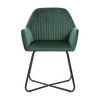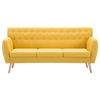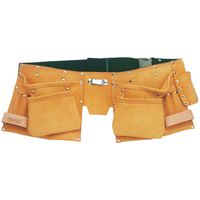Keep your tools organised with a tool bag
In the world of DIY projects and professional craftsmanship, a tool bag stands out as a must-have for individuals who pride themselves on their handy skills. These versatile bags provide an efficient and organised solution for keeping tools within arm's reach while working on various projects. Whether you're a seasoned professional or a weekend warrior, a tool bag proves to be an essential asset, streamlining your workflow. They ensure that every wrench, screwdriver and plier is right where you need it.
Keeping your tools in check
One of the primary advantages of a tool bag is its ability to keep tools organised. When embarking on a project, the last thing you want is to spend valuable time searching for the right tool amidst a cluttered workspace. Tool bags come equipped with multiple compartments, pockets and dividers, providing designated spaces for each tool. This not only saves time but also enhances efficiency, allowing you to focus on the task at hand without the distraction of a dishevelled tool collection.
Imagine the convenience of having your screwdrivers neatly arranged, your wrenches in perfect order and your pliers easily accessible. The tool bag's design ensures that each tool has its place, eliminating the frustration of rummaging through a toolbox or searching pockets for a missing item. This level of organisation not only enhances productivity but also contributes to the longevity of your tools by preventing unnecessary wear and tear.
Must-have tools for your tool bag
A well-equipped tool bag is the hallmark of a prepared and efficient craftsman, ready to tackle any project that comes their way. Whether you're a seasoned professional or a DIY enthusiast, certain tools stand out as must-haves, ensuring you're always equipped to handle diverse tasks. Let's delve into the essential tools that deserve a spot in your tool bag.
-
Screwdrivers: No toolkit is complete without a set of quality screwdrivers. From assembling furniture to tightening electrical connections, screwdrivers are versatile tools that come in various shapes and sizes. Consider including both flathead and Phillips-head screwdrivers to ensure you're prepared for any screw-related task. Look for screwdrivers with ergonomic handles for a comfortable grip during extended use.
-
Pliers: Pliers are indispensable when it comes to gripping, bending and cutting. A pair of needle-nose pliers can reach into tight spaces, while lineman's pliers provide a sturdy grip for cutting and twisting wires. Including a set of pliers in your tool bag ensures you have the right tool for tasks that require precision and strength.
-
Hammer: A hammer is a fundamental tool that transcends various trades. Whether you're framing a wall, assembling wooden structures, or driving nails into place, a sturdy hammer is a must. Consider the weight of the hammer to find one that suits your preferences and the tasks at hand.
-
Tape measure: Accurate measurements are the foundation of successful projects. A tape measure is an essential tool for carpentry, construction and even simple home improvement tasks. Look for a tape measure with a lock mechanism for easy measurements and a durable case to withstand the rigours of regular use.
-
Adjustable wrench: For tasks involving nuts and bolts, an adjustable wrench is a versatile companion. Its adjustable jaw allows it to accommodate various sizes of fasteners, making it a go-to tool for plumbing, automotive repairs and general maintenance. Ensure that the wrench has a smooth adjustment mechanism for efficiency.
-
Utility knife: When precision cutting is required, a utility knife is your best friend. From opening packages to trimming materials, a sharp utility knife is a versatile and essential tool. Look for one with a retractable blade for safety and easy storage in your tool bag.
-
Drill: For tasks that require speed and efficiency, a cordless drill is a game-changer. From drilling holes to driving screws, a drill expedites many processes, saving both time and effort. Make sure your drill is accompanied by a set of drill bits and screwdriver attachments for maximum versatility.
-
Level: Achieving straight and level surfaces is crucial in many construction projects. A spirit level ensures accuracy, helping you hang shelves, install cabinets and frame walls with precision. A compact and durable level is an invaluable addition to your toolkit.
-
Safety gear: No toolkit is complete without safety gear. Include essentials like safety glasses, gloves and ear protection to safeguard yourself from potential hazards. Whether you're cutting, drilling or hammering, prioritise your safety to ensure you can continue tackling projects for years to come.
How to keep your workshop organised
A well-organised workshop is not just a space; it's a sanctuary for creativity, productivity and efficiency. Whether you're a woodworking enthusiast, a DIY hobbyist, or a professional tradesperson, maintaining an organised workshop can significantly enhance your workflow and overall experience.
-
Clean up: The first step in maintaining an organised workshop is to start with a clean slate. Before and after each project, take the time to clean up. Also make sure you take the time to put away tools. This not only ensures that your workspace is ready for the next task but also prevents clutter from accumulating. Develop a routine of sweeping the floors, wiping down surfaces and organising tools at the end of each work session.
-
Tool bags: Investing in a good tool bag is a game-changer for workshop organisation. A tool bag allows you to keep your essential tools in one place, making them easily accessible and portable. Categorise your tools in the bag, utilising its various compartments for screwdrivers, pliers, wrenches and other essentials. The portability of a tool bag enables you to carry your most-used tools directly to the project, minimising back-and-forth trips to the toolbox.
-
A place for everything: Assign specific areas or zones for different types of tools and materials in your workshop. For instance, create a designated space for hand tools, power tools and consumables. Clearly mark and label these zones to make it easy to locate and return items. This practice not only helps maintain order but also saves valuable time searching for tools when you need them.
-
Invest in storage solutions: Optimise your workshop's vertical space by investing in shelves, cabinets and pegboards. Wall-mounted shelves and pegboards are excellent for storing tools, keeping them within arm's reach. Utilise clear storage bins for smaller items, ensuring visibility and easy access. By utilising vertical storage solutions, you free up valuable floor space and create a visually organised environment.
-
Label everything: Labels are your best friends when it comes to maintaining order. Label drawers, bins and shelves to clearly indicate the contents of each. This not only helps you find items quickly but also encourages others sharing the workshop space to return tools and materials to their designated spots. Consider colour-coding labels for an additional layer of organisation.
-
Create a workspace hierarchy: Designate specific workstations for different tasks and organise tools accordingly. For instance, keep woodworking tools near the bench designated for woodworking projects and electrical tools near the electrical workbench. This not only streamlines your workflow but also minimises the need to constantly move tools from one end of the workshop to another.
-
Regular maintenance checks: In addition to organising your workspace, it's crucial to conduct regular maintenance checks on your tools and equipment. Inspect for wear and tear, damaged cords or malfunctioning parts. Address any issues promptly to prevent accidents and ensure that your tools remain in top working condition. Regular maintenance also extends the lifespan of your tools, saving you money in the long run.
-
Safety first: Prioritise safety by organising your workshop with emergency situations in mind. Ensure that fire extinguishers, first aid kits and emergency exits are easily accessible. Establish a safety zone where protective gear, such as goggles and ear protection, is stored. An organised and safety-conscious workshop is not only a productive, but also secure workshop.
-
Review and refine: Finally, treat your workshop organisation as an evolving process. Regularly review and refine your organisational systems based on your project requirements. Be open to adjusting storage solutions, rearranging workstations and incorporating new tools or technologies that enhance efficiency.
















































